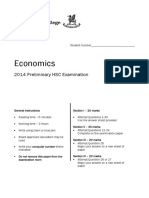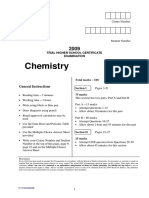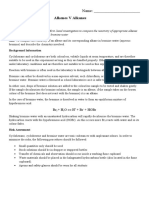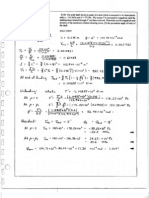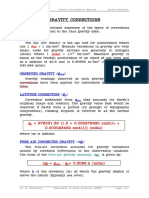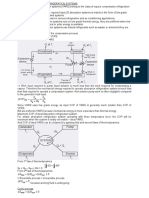Physics Trial 2013 - JRAHS - Questions
Physics Trial 2013 - JRAHS - Questions
Uploaded by
LisWeiCopyright:
Available Formats
Physics Trial 2013 - JRAHS - Questions
Physics Trial 2013 - JRAHS - Questions
Uploaded by
LisWeiOriginal Title
Copyright
Available Formats
Share this document
Did you find this document useful?
Is this content inappropriate?
Copyright:
Available Formats
Physics Trial 2013 - JRAHS - Questions
Physics Trial 2013 - JRAHS - Questions
Uploaded by
LisWeiCopyright:
Available Formats
Student Number
2013
TRIAL HSC Mark / 100
EXAMINATION
Physics
General Instructions Total Marks – 100
Section I Pages 2 - 22
• Reading time – 5 minutes
• Working time – 3 hours 75 marks
Confidential
• Write using black or blue pen
• Draw diagrams using pencil This section has two parts, Part A and Part B
Keep Secure
• Write your Student Number at the top of this page
Part A – 20 marks
and on the response sheets on page 10 and 11
•Attempt Questions 1- 20
• Board-approved calculators may be used •Allow about 30 minutes for this part
• A data sheet and a Periodic Table are provided
Part B – 55 marks
•Attempt Questions 21 - 31
•Allow about 1 hour and 45 minutes for this part
Section II Page 23
25 marks
•Attempt Question 32
•Allow about 45 minutes for this section
JRAHS 2013 Physics HSC Trial Examination Page 1
Section I
75 marks
Part A – 20 marks
Attempt Questions 1-20
Allow about 30 minutes for this part
Use the multiple choice answer sheet on page 10.
JRAHS 2013 Physics HSC Trial Examination Page 2
1. A person stands on a scale in an elevator. He notices that the scale reading is lower than his
normal ‘weight’.
Which of the following could possibly describe the motion of the elevator?
(A) It is moving up and slowing down.
(B) It is moving up and speeding up.
(C) It is moving down at constant speed.
(D) It is moving down and slowing down.
2. A ball is projected horizontally with a speed of 40 ms-1 from the top of a cliff on the surface of
the Earth.
What will be its approximate speed 3.0 s later if there were no air resistance?
(A) 30 ms-1
(B) 40 ms-1
(C) 50 ms-1
(D) 60 ms-1
3. A moon of a planet Rusean has an orbital period of 5 days and is at a distance of 5 units from the
centre of the planet. Another moon is discovered at a distance of 20 units from the centre of Rusean.
Which of the following will be closest to the orbital period of the newly discovered moon?
(A) 40 days
(B) 20 days
(C) 13 days
(D) 5 days
4. The Space Shuttle orbits 300 km above the Earth's surface. If the Earth's radius is 6400 km, what
is the gravitational acceleration experienced by the Space Shuttle while in this orbit?
(A) 4.9 ms-2
(B) 8.9 ms-2
(C) 9.8 ms-2
(D) 10.8 ms-2
JRAHS 2013 Physics HSC Trial Examination Page 3
5. The minimum initial velocity required by a space probe to just escape the gravitational pull of a
planet is called escape velocity.
Which of the following quantities does NOT affect the magnitude of the escape velocity?
(A) mass of the planet
(B) mass of the space probe
(C) radius of the planet
(D) universal gravitational constant
6. The gravitational potential energy of two masses at a distance 2.0 m apart is - 8.0 J.
What external work must be done on this system to separate the masses to a distance of 4.0 m?
(A) - 4.0 J
(B) - 2.0 J
(C) + 2.0 J
(D) + 4.0 J
7. Astronauts on a long space journey are playing golf inside their spaceship, which is travelling away
from the Earth with speed 0.6 c . One of the astronauts hits a drive exactly along the length of the
spaceship (in its direction of travel) at speed 0.1 c in the frame of the spaceship.
What is the speed of the golf ball as observed from Earth?
(A) 0. 74 c
(B) 0.7 c
(C) 0.66 c
(D) 0.5 c
8. How does a moving coil galvanometer operate?
(A) by balancing the torque on a current-carrying coil with the torque on a coil spring
(B) by balancing the current induced in a coil with the applied current
(C ) by producing a magnetic field that is balanced by a coil spring
(D) by inducing a current in the coil that is placed in a magnetic field
JRAHS 2013 Physics HSC Trial Examination Page 4
9. A current flows in a straight wire placed perpendicular to a uniform magnetic field. The current
varies with time as shown on the diagram below.
Which statement best describes the magnetic force acting on the wire?
(A) It has a constant magnitude but changing direction.
(B) It has both a constant magnitude and direction.
(C) It has both a changing magnitude and direction.
(D) It has a changing magnitude but constant direction.
10. The figure below shows a straight wire carrying a steady current from X to Y. The wire is
suspended between the poles of two similar permanent magnets, each of which produces a
uniform magnetic field between the N and S poles.
What will the wire experience?
(A) a force in the direction XY
(B) a force in the upward direction
(C) a torque tending to rotate the wire about an axis parallel to the magnetic field
(D) no resultant force
JRAHS 2013 Physics HSC Trial Examination Page 5
11. A copper ring hangs vertically from a thread with its axis along the axis of a coil as shown in the
diagram.
What is the initial direction of motion of the copper ring when the switch K is closed?
(A) P
(B) Q
(C) R
(D) S
12. A straight current-carrying conductor is placed within an external magnetic field as
shown below.
What is the magnitude of the force on the conductor carrying a current of 3 A?
(A) 0.12 N
(B) 0.15 N
(C) 0.18 N
(D) 0.24 N
JRAHS 2013 Physics HSC Trial Examination Page 6
13. A simple DC motor has n turns of wire in the armature and has an area of A m2. A current of I
o
amperes passes through the armature. The plane of the armature is at 0 to the direction of the
magnetic field of strength B Teslas.
What is the torque on the armature if the area and the current are doubled and the armature is at
o
an angle of 60 to the magnetic field direction?
(A) twice the original torque
(B) four times the original torque
(C) equal to the original torque
(D) half the original torque
14. AC induction motors are commonly used in small power tools around the home.
Which of the following statements correctly describes the working of an AC induction motor?
(A) A changing magnetic flux from the stator induces a current in the rotor causing it to spin in the
same direction as the changing field.
(B) A constant magnetic flux from the stator induces a current in the rotor causing it to spin in the
same direction as the field.
(C) A changing magnetic flux from the stator induces a current in the rotor causing it to spin in the
opposite direction to the changing field.
(D) A constant magnetic flux from the stator induces a current in the rotor causing it to spin in the
opposite direction as the field.
15. At room temperature, what is the current in an intrinsic semiconductor due to?
(A) movement of holes
(B) movement of electrons
(C) movement of holes and electrons
(D) none of the above
JRAHS 2013 Physics HSC Trial Examination Page 7
16. Which of the following correctly describes a photon?
(A) It is a unit of energy,
(B) It is an electron emitted from a metal surface by the action of light.
(C) It is an electron emitted from a metal surface by the action of heat.
(D) It is a quantum of electromagnetic radiation.
17. William Bragg and his son Lawrence studied crystals and Lawrence determined the mathematical
formula:
n λ = d sin
Which of the following did this formula allow them to determine?
(A) the number of electrons in an atom
(B) the mass of atoms
(C) the charge on an electron
(D) the internal arrangement of atoms in crystals
18. Which statement, according to the BCS theory of superconductivity, is correct?
(A) Superconductivity occurs because the crystal lattice causes electron pairs to break up.
(B) Distortions of the crystal lattice by electron movement cause superconductivity to cease.
(C) Distortions of the crystal lattice allow electrons to pair up and flow unimpeded.
(D) Superconductivity occurs because low temperatures cause the crystal lattice to stop vibrating
and remain free from distortion.
JRAHS 2013 Physics HSC Trial Examination Page 8
19. The following is a list of some possible properties of high temperature superconductors. Some may be
incorrect.
1. Relatively hard to produce
2. Only made from metals
3. Not very ductile
4. Can be brittle
Which of the above would be considered as correct limitations to modern high temperature
superconductors?
(A) 2 and 3
(B) 1, 3 and 4
(C) 2, 3 and 4
(D) 1, 2, 3 and 4
20. Inside a discharge tube producing cathode rays, a freely rotatable wheel is mounted. When cathode
rays fall on it the wheel starts rotating.
What does this experiment indicate about cathode rays?
(A) Cathode rays are charged particles.
(B) Cathode rays are energetic rays.
(C) Cathode rays are particles having momentum.
(D) Cathode rays are electromagnetic waves.
JRAHS 2013 Physics HSC Trial Examination Page 9
Student Number ……………………
Section I Mark ----- /20
Part A
Multiple Choice Answer Sheet
1. A B C D
2. A B C D
3. A B C D
4. A B C D
5. A B C D
6. A B C D
7. A B C D
8. A B C D
9. A B C D
10. A B C D
11. A B C D
12. A B C D
13 A B C D
14. A B C D
15. A B C D
16. A B C D
17. A B C D
18. A B C D
19. A B C D
20. A B C D
JRAHS 2013 Physics HSC Trial Examination Page 10
Part B 55 marks Student No. …………………
Attempt questions 21 - 31
Allow about 1 hour and 45 minutes for this part
Show all relevant working in questions involving calculations
Question 21 (6 Marks) Marks
An archer shoots an arrow at a 22o angle to the horizontal. At the top of its motion, the arrow
just clears a 36 m high gum tree.
(a) Determine the speed of the arrow when it left the bow. 3
Assume it was shot from 1 m above the ground.
...............................................................................................................................................................
...............................................................................................................................................................
...............................................................................................................................................................
...............................................................................................................................................................
...............................................................................................................................................................
...............................................................................................................................................................
...............................................................................................................................................................
...............................................................................................................................................................
...............................................................................................................................................................
...............................................................................................................................................................
(b) How far away is the archer from the foot of the tree? 3
...............................................................................................................................................................
...............................................................................................................................................................
...............................................................................................................................................................
...............................................................................................................................................................
...............................................................................................................................................................
...............................................................................................................................................................
...............................................................................................................................................................
...............................................................................................................................................................
JRAHS 2013 Physics HSC Trial Examination Page 11
Question 22 (5 marks) Marks
The following information applies to the Space Shuttle during the first 120 seconds of its launch.
Mass of space shuttle at 0 s 2 051 113 kg
Thrust force from the rocket engines is constant by first-stage burn 3.0 x 107 N
Mass loss per second due to rocket discharge of fuel 1.3 x 104 kg
Frictional forces due to the atmosphere decrease with height
(a) Describe qualitatively and quantitatively how the g forces acting on the astronauts vary 4
during the first 120 seconds.
Compare them to the g forces on the astronaut while the rocket is at rest.
...............................................................................................................................................................
...............................................................................................................................................................
...............................................................................................................................................................
...............................................................................................................................................................
...............................................................................................................................................................
...............................................................................................................................................................
...............................................................................................................................................................
...............................................................................................................................................................
...............................................................................................................................................................
...............................................................................................................................................................
...............................................................................................................................................................
...............................................................................................................................................................
...............................................................................................................................................................
(b) Sketch two graphs, on the same axes, to show how the velocity and kinetic energy of the 1
shuttle varies during the first 120 seconds. (No numerical values are required).
Use different labelled lines to show velocity and kinetic energy.
.
0 120 t (s)
JRAHS 2013 Physics HSC Trial Examination Page 12
Question 23 (5 marks) Marks
Assess the use of thought experiments in the development of our current understanding of time.
......................................................................................................................................................
......................................................................................................................................................
......................................................................................................................................................
......................................................................................................................................................
......................................................................................................................................................
......................................................................................................................................................
......................................................................................................................................................
......................................................................................................................................................
......................................................................................................................................................
......................................................................................................................................................
......................................................................................................................................................
......................................................................................................................................................
......................................................................................................................................................
......................................................................................................................................................
......................................................................................................................................................
......................................................................................................................................................
......................................................................................................................................................
......................................................................................................................................................
......................................................................................................................................................
......................................................................................................................................................
......................................................................................................................................................
......................................................................................................................................................
......................................................................................................................................................
......................................................................................................................................................
......................................................................................................................................................
......................................................................................................................................................
......................................................................................................................................................
......................................................................................................................................................
......................................................................................................................................................
......................................................................................................................................................
......................................................................................................................................................
......................................................................................................................................................
JRAHS 2013 Physics HSC Trial Examination Page 13
Question 24 (7 marks) Marks
A closed loop is made of a U-shaped metal wire of negligible resistance and a movable metal
crossbar of resistance R. The crossbar has mass m and length L. It is initially located a distance
h0 from the other end of the loop. The loop is placed vertically in a uniform horizontal magnetic
field of magnitude B0 in the direction shown in the figure above.
Express all algebraic answers to the questions below in terms of B0, L, m, h0, R, and fundamental
constants, as appropriate.
(a) Determine the magnitude of the magnetic flux through the loop when the crossbar is in the 1
position shown.
......................................................................................................................................................
......................................................................................................................................................
The crossbar is released from rest and slides with negligible friction down the U-shaped wire
without losing electrical contact.
(b) On the figure below, indicate the direction of the current in the crossbar as it falls. 3
Justify your answer.
crossbar
......................................................................................................................................................
......................................................................................................................................................
......................................................................................................................................................
......................................................................................................................................................
......................................................................................................................................................
......................................................................................................................................................
......................................................................................................................................................
......................................................................................................................................................
Question 24 continues on the next page
JRAHS 2013 Physics HSC Trial Examination Page 14
Question 24 (continued) Marks
(c) If the resistance, R, of the crossbar now is increased, will the initial speed of the crossbar 1
increase, decrease, or remain the same as before?
Circle the correct answer below.
Increases Decreases Remains the same
\
(d) Justify your answer in (c) in terms of the forces on the crossbar. 2
......................................................................................................................................................
......................................................................................................................................................
......................................................................................................................................................
......................................................................................................................................................
......................................................................................................................................................
......................................................................................................................................................
......................................................................................................................................................
......................................................................................................................................................
JRAHS 2013 Physics HSC Trial Examination Page 15
Question 25 (4 marks) Marks
A student conducts two investigations with a bar magnet. First, a bar magnet is suspended
horizontally by a piece of thread and allowed to oscillate about a vertical axis through its centre,
(i) above a piece of glass plate, and then
(ii) above a piece of copper plate.
Describe and explain what the student will observe in each investigation.
......................................................................................................................................................
......................................................................................................................................................
......................................................................................................................................................
......................................................................................................................................................
......................................................................................................................................................
......................................................................................................................................................
......................................................................................................................................................
......................................................................................................................................................
......................................................................................................................................................
......................................................................................................................................................
......................................................................................................................................................
......................................................................................................................................................
......................................................................................................................................................
......................................................................................................................................................
JRAHS 2013 Physics HSC Trial Examination Page 16
Question 26 (2 marks) Marks
Models are often used in Science to explain phenomena. The model below is found in a
textbook and is used to explain conduction in semi-conductors, conductors and insulators.
The model correctly explains semi-conductors and insulator behaviour.
In conductors, with reference to the diagram, what aspect of metal conductivity behaviour does
the model not explain?
........................................................................................................................................................
........................................................................................................................................................
........................................................................................................................................................
........................................................................................................................................................
........................................................................................................................................................
........................................................................................................................................................
........................................................................................................................................................
JRAHS 2013 Physics HSC Trial Examination Page 17
Question 27 (4 marks) Marks
(a) An ideal transformer has a primary coil with 36 loops, a current of 0.900 A and a voltage 1
of 7.0 V.
What is the voltage of the secondary coil if it’s current is 0.675 A?
......................................................................................................................................................
......................................................................................................................................................
......................................................................................................................................................
......................................................................................................................................................
(b) With the same primary coil described in (a), how many loops will need to be in the secondary 1
coil to have a current of 2.7 A?
......................................................................................................................................................
......................................................................................................................................................
......................................................................................................................................................
......................................................................................................................................................
(c) Why are transformers dependent on AC current? 2
......................................................................................................................................................
......................................................................................................................................................
......................................................................................................................................................
......................................................................................................................................................
......................................................................................................................................................
......................................................................................................................................................
......................................................................................................................................................
......................................................................................................................................................
JRAHS 2013 Physics HSC Trial Examination Page 18
Question 28 (5 Marks) Marks
Assess the impact on society and the environment of the potential applications of superconductors
in motors and generators, and in power transmission.
......................................................................................................................................................
......................................................................................................................................................
......................................................................................................................................................
......................................................................................................................................................
......................................................................................................................................................
......................................................................................................................................................
......................................................................................................................................................
......................................................................................................................................................
......................................................................................................................................................
......................................................................................................................................................
......................................................................................................................................................
......................................................................................................................................................
......................................................................................................................................................
......................................................................................................................................................
......................................................................................................................................................
......................................................................................................................................................
......................................................................................................................................................
......................................................................................................................................................
......................................................................................................................................................
......................................................................................................................................................
......................................................................................................................................................
......................................................................................................................................................
......................................................................................................................................................
JRAHS 2013 Physics HSC Trial Examination Page 19
Question 29 (4 marks) Marks
(a) With the aid of a labelled diagram, explain briefly how electrons are produced in a 2
Cathode Ray Oscilloscope.
......................................................................................................................................................
......................................................................................................................................................
......................................................................................................................................................
......................................................................................................................................................
......................................................................................................................................................
(b) Outline how these electrons are given a high velocity. 1
......................................................................................................................................................
......................................................................................................................................................
......................................................................................................................................................
......................................................................................................................................................
(c) Outline how the beam of electrons can be made to move vertically. 1
......................................................................................................................................................
......................................................................................................................................................
......................................................................................................................................................
......................................................................................................................................................
......................................................................................................................................................
JRAHS 2013 Physics HSC Trial Examination Page 20
Question 30 (8 Marks) Marks
In a photoelectric emission experiment, a metal surface in an evacuated tube is illuminated
with monochromatic light and a current is detected. If the experiment is repeated with light of
the same wavelength but of twice the intensity, explain how it would affect the following:
(a) the energy of the photon,
(b) the maximum kinetic energy of the photoelectrons,
(c) the work function of the metal,
(d) the photoelectric current.
(a) ...................................................................................................................................................... 2
..........................................................................................................................................................
..........................................................................................................................................................
..........................................................................................................................................................
(b) ..................................................................................................................................................... 2
..........................................................................................................................................................
..........................................................................................................................................................
..........................................................................................................................................................
(c)..................................................................................................................................................... 2
..........................................................................................................................................................
..........................................................................................................................................................
..........................................................................................................................................................
(d) ...................................................................................................................................................... 2
..........................................................................................................................................................
..........................................................................................................................................................
..........................................................................................................................................................
JRAHS 2013 Physics HSC Trial Examination Page 21
Question 31 (5 marks) Marks
A student performed an experiment to determine the strength of a constant, uniform magnetic
field by measuring the radius of the path of a beam of electrons moving at various speeds in a
this magnetic field.
The student’s data is presented below.
v ( 107 ms-1) r ( 10-3 m)
1.0 0.6
2.0 1.1
3.0 1.7
4.0 2.3
5.0 2.8
(a) Plot the data from the table and draw a graph. 1
radius
r 3
( 10-3 m)
0
0 1 2 3 4 5
speed v ( 107 ms-1)
Question 31 continues on the next page
JRAHS 2013 Physics HSC Trial Examination Page 22
Question 31 (continued) Marks
(b) Use the gradient of the graph to determine the magnitude of the magnetic field as electrons 4
move in their circular paths. Show all working.
......................................................................................................................................................
......................................................................................................................................................
......................................................................................................................................................
......................................................................................................................................................
......................................................................................................................................................
......................................................................................................................................................
......................................................................................................................................................
......................................................................................................................................................
......................................................................................................................................................
......................................................................................................................................................
......................................................................................................................................................
......................................................................................................................................................
JRAHS 2013 Physics HSC Trial Examination Page 23
Section II
Question 32– From Quanta to Quarks (25 marks) Marks
Allow about 45 minutes for this section
(a) When hot hydrogen vapour is viewed through a spectrometer, four distinct bright lines of
the Balmer series can be seen. The wavelengths of these lines are given in the table below.
Balmer series
6.562 x 10-7 m
4.861 x 10-7 m
4.340 x 10-7 m
4.102 x 10-7 m
(i) By referring to the Bohr model of the atom, describe how these lines are formed. 2
(ii) Apply the Rydberg equation to show how any ONE of the lines can be predicted. 2
(b) (i) The nuclide decays to the nuclide in 4 successive radioactive decays. 1
Each decay involves the emission of either an alpha or a beta particle.
What is the value of A ?
(ii) The actual mass of the atom is 119.9045 u. Calculate its mass defect, given 1
the following data:
Proton mass 1.0073 u
Neutron mass 1.0087 u
Electron mass 0.00055 u
(iii) What is the energy equivalent of this mass defect? 1
JRAHS 2013 Physics HSC Trial Examination Page 24
Question 32 (continued) Marks
(c) (i) Using a labelled diagram outline ONE way in which physicists obtain particles with 5
the appropriate energy to investigate the structure of matter.
(ii) Give ONE other application of the technology outlined above. 1
(d) Describe how de Broglie’s proposal was confirmed by Davisson and Germer. 4
(e) The diagram shows a fission nuclear reactor.
(i) Identify the parts labelled 2 and 3 in the diagram. 2
(ii) State the function of the parts labelled 1 and 3 in the diagram. 2
(f) Until the second half of the twentieth century, the proton, neutron and electron were thought 4
to be fundamental particles of matter.
Justify how the introduction of quarks and leptons, and strong and weak forces in the
standard model, has changed our understanding of particle physics.
End of examination
JRAHS 2013 Physics HSC Trial Examination Page 25
You might also like
- Physics in Focus (Year 12 Student Book), 2nd Edition Robert Farr All Chapter Instant DownloadDocument53 pagesPhysics in Focus (Year 12 Student Book), 2nd Edition Robert Farr All Chapter Instant Downloadmantledorry100% (4)
- Atar NotesDocument1 pageAtar NotesWilliam SaikalyNo ratings yet
- QASMT Writing Style Guide APADocument35 pagesQASMT Writing Style Guide APAPingHsuNo ratings yet
- UCAT Practice Test Results 637354262214053584 PDFDocument1 pageUCAT Practice Test Results 637354262214053584 PDFAyanHabaneNo ratings yet
- Physics 2018 Year 11 Preliminary TaskDocument11 pagesPhysics 2018 Year 11 Preliminary TaskSyed HasanNo ratings yet
- Physics 2019 Year 11 Preliminary TaskDocument11 pagesPhysics 2019 Year 11 Preliminary TaskSyed Hasan100% (1)
- 2019 Trial Physics ExamDocument28 pages2019 Trial Physics ExamJun SungNo ratings yet
- Baulkham Hills 2016 Physics Prelim Yearly & SolutionsDocument29 pagesBaulkham Hills 2016 Physics Prelim Yearly & SolutionsTharanga Mudalige100% (1)
- 2014 Physics TRIAL QuestionsDocument28 pages2014 Physics TRIAL QuestionsLisWeiNo ratings yet
- Sydney Boys 2019 Chemistry Trial PaperDocument30 pagesSydney Boys 2019 Chemistry Trial PaperYuanfeng WeiNo ratings yet
- 2010 JR HSC Chemistry TrialsDocument23 pages2010 JR HSC Chemistry Trialsedmond1200100% (1)
- James Ruse 2012 Chemistry Trials & SolutionsDocument53 pagesJames Ruse 2012 Chemistry Trials & SolutionsYe ZhangNo ratings yet
- 2010 Ruse Trial PDFDocument23 pages2010 Ruse Trial PDFKNo ratings yet
- James Ruse 2021 Physics Trials & SolutionsDocument78 pagesJames Ruse 2021 Physics Trials & Solutionsfortnitegamerpro123451No ratings yet
- Sydney Boys 2020 Chemistry Trials & SolutionsDocument38 pagesSydney Boys 2020 Chemistry Trials & SolutionsNhân Lê Nguyễn ThiệnNo ratings yet
- James Ruse 2014 Chemistry Trials & SolutionsDocument53 pagesJames Ruse 2014 Chemistry Trials & SolutionsYe ZhangNo ratings yet
- SBHS Preliminary Chemistry Yearly ExDocument19 pagesSBHS Preliminary Chemistry Yearly ExGary ZhangNo ratings yet
- James Ruse 2013 Chemistry Trials & SolutionsDocument52 pagesJames Ruse 2013 Chemistry Trials & SolutionsYe ZhangNo ratings yet
- James Ruse 2022 Chemistry Trials & SolutionsDocument68 pagesJames Ruse 2022 Chemistry Trials & Solutionsnehakeyshore1No ratings yet
- James Ruse 2003 Biology Prelim YearlyDocument19 pagesJames Ruse 2003 Biology Prelim YearlyDogNo ratings yet
- James Ruse 2009 Chemistry Trials & SolutionsDocument56 pagesJames Ruse 2009 Chemistry Trials & SolutionsHenry JenkinsNo ratings yet
- James Ruse 2020 Chemistry Trials & SolutionsDocument63 pagesJames Ruse 2020 Chemistry Trials & SolutionsNhân Lê Nguyễn ThiệnNo ratings yet
- James Ruse 2019 Chemistry Trials & Solutions PDFDocument55 pagesJames Ruse 2019 Chemistry Trials & Solutions PDFBen MilnerNo ratings yet
- Sydney Boys 2020 Physics Trials & SolutionsDocument56 pagesSydney Boys 2020 Physics Trials & SolutionsaNo ratings yet
- Fort ST 2019 Chemistry Trial PaperDocument46 pagesFort ST 2019 Chemistry Trial PaperYuanfeng WeiNo ratings yet
- James Ruse 2015 Chemistry Trials & SolutionsDocument54 pagesJames Ruse 2015 Chemistry Trials & SolutionsYe ZhangNo ratings yet
- Baulkham Hills 2020 Chemistry Trials & SolutionsDocument35 pagesBaulkham Hills 2020 Chemistry Trials & SolutionsNhân Lê Nguyễn ThiệnNo ratings yet
- James Ruse 2021 Chemistry Trials & SolutionsDocument63 pagesJames Ruse 2021 Chemistry Trials & Solutionskaylasadgrove4No ratings yet
- 2017 Qats Units 3 4Document31 pages2017 Qats Units 3 4kaustubhsontyNo ratings yet
- 2019 James Ruse Term 1Document17 pages2019 James Ruse Term 1asjvbsajkvbasjkvasbvjkNo ratings yet
- Normo 2021 Extension 2 Mathematics TrialDocument13 pagesNormo 2021 Extension 2 Mathematics TrialSuleyman KumsuzNo ratings yet
- HSC Physics Space WorkbookDocument32 pagesHSC Physics Space Workbookphil megroin100% (1)
- Chemistry Year 11 2021Document25 pagesChemistry Year 11 2021willNo ratings yet
- Preliminary Chemistry Study Notes (Part 2)Document31 pagesPreliminary Chemistry Study Notes (Part 2)dan964100% (1)
- Newington 2014 Economics Prelim Yearly & Solutions PDFDocument25 pagesNewington 2014 Economics Prelim Yearly & Solutions PDFEren SevinceNo ratings yet
- 2022 3U - Sydney Girls - Trial Paper (With Solutions)Document33 pages2022 3U - Sydney Girls - Trial Paper (With Solutions)Rodney KNo ratings yet
- Y10 Science Semester 2 Exam Paper 2014Document28 pagesY10 Science Semester 2 Exam Paper 2014Joshua JohnNo ratings yet
- James Ruse 2006 Year 10 Maths Yearly & Solutions PDFDocument18 pagesJames Ruse 2006 Year 10 Maths Yearly & Solutions PDFYe ZhangNo ratings yet
- Organic Chem Test 2020 LisachemDocument26 pagesOrganic Chem Test 2020 LisachemMahhe AbdulahiNo ratings yet
- Physics Preliminary NSW HSCDocument32 pagesPhysics Preliminary NSW HSCFatima SaadNo ratings yet
- North Sydney Boys 2016 Year 10 Maths Yearly & SolutionsDocument13 pagesNorth Sydney Boys 2016 Year 10 Maths Yearly & SolutionsAditiPriyankaNo ratings yet
- Unit Plan - Year 7 Science States of MatterDocument23 pagesUnit Plan - Year 7 Science States of Matterapi-708755416No ratings yet
- Pip Writing GuideDocument6 pagesPip Writing Guideapi-315292554No ratings yet
- Science Extension Module-4 NotesDocument2 pagesScience Extension Module-4 Notestetece8105No ratings yet
- Specification Points Covered: Ionic SubstancesDocument11 pagesSpecification Points Covered: Ionic SubstancesIsabella ThomasNo ratings yet
- Year 11 Economics Mock 1 Paper 2Document5 pagesYear 11 Economics Mock 1 Paper 2brianbandaNo ratings yet
- 2022 3U - ST George Girls - Trial Paper (With Solutions)Document35 pages2022 3U - ST George Girls - Trial Paper (With Solutions)Rodney KNo ratings yet
- 2009 QAT HSC Chemistry ExamDocument32 pages2009 QAT HSC Chemistry ExamomhreemaimhreemNo ratings yet
- HCHEM33 Equilibrium-and-Acid-Reactions-IIIDocument29 pagesHCHEM33 Equilibrium-and-Acid-Reactions-IIISNo ratings yet
- Sydney Girls E1 2018 PDFDocument37 pagesSydney Girls E1 2018 PDFEarlNo ratings yet
- Abbotsleigh 2016 2U Trials & SolutionsDocument33 pagesAbbotsleigh 2016 2U Trials & SolutionsVeda IyerNo ratings yet
- BIOLOGY: MODULE 4 Biodiversity, Evolution & Disease Notes PDFDocument10 pagesBIOLOGY: MODULE 4 Biodiversity, Evolution & Disease Notes PDFschool adressNo ratings yet
- PR1ME Summative Tests NZ 2B Test 3Document14 pagesPR1ME Summative Tests NZ 2B Test 3Tina HsuNo ratings yet
- 2015 Roseville Year 7 Mathematics Term 4 Paper 1Document11 pages2015 Roseville Year 7 Mathematics Term 4 Paper 1Shahrazad8No ratings yet
- 2021 Hurlstone Mathematics Advanced Task 1 W Solutions 61337b9fa3e9aDocument12 pages2021 Hurlstone Mathematics Advanced Task 1 W Solutions 61337b9fa3e9athomassiskas1No ratings yet
- 8th Science Eog Study GuideDocument11 pages8th Science Eog Study Guideapi-353567032No ratings yet
- Trial 2013 Draft 6 QuestonsDocument25 pagesTrial 2013 Draft 6 QuestonsLisWeiNo ratings yet
- 2011 Trial Physics AnswersDocument27 pages2011 Trial Physics AnswersGeorgeNo ratings yet
- Physics Trial ExamDocument27 pagesPhysics Trial ExamaNo ratings yet
- Year11 JRAHS 2006 Assessment Test For Term 4 Page: 1Document9 pagesYear11 JRAHS 2006 Assessment Test For Term 4 Page: 1LisWeiNo ratings yet
- 2010-08-09 - The Hero's Journey in Myths and MoviesDocument8 pages2010-08-09 - The Hero's Journey in Myths and MoviesLisWeiNo ratings yet
- Year11 JRAHS 2006 Assessment Test For Term 4 Page: 1Document7 pagesYear11 JRAHS 2006 Assessment Test For Term 4 Page: 1LisWeiNo ratings yet
- Story Pyramid: Thursday, 11 MarchDocument1 pageStory Pyramid: Thursday, 11 MarchLisWeiNo ratings yet
- Tut 1Document1 pageTut 1LisWeiNo ratings yet
- 2010 Yr7 Common Assessment Task - Semester 2 (MSND Oral)Document3 pages2010 Yr7 Common Assessment Task - Semester 2 (MSND Oral)LisWeiNo ratings yet
- Trial 2013 Draft 6 QuestonsDocument25 pagesTrial 2013 Draft 6 QuestonsLisWeiNo ratings yet
- James Ruse Agricultural High School: PhysicsDocument12 pagesJames Ruse Agricultural High School: PhysicsLisWeiNo ratings yet
- Year11 JRAHS 2006 Assessment Test For Term 4 Page: 1Document7 pagesYear11 JRAHS 2006 Assessment Test For Term 4 Page: 1LisWeiNo ratings yet
- Tempest - Act SummaryDocument3 pagesTempest - Act SummaryLisWeiNo ratings yet
- James Ruse Agricultural High School: PhysicsDocument13 pagesJames Ruse Agricultural High School: PhysicsLisWeiNo ratings yet
- 2014 Task 2 - TheoryDocument13 pages2014 Task 2 - TheoryLisWeiNo ratings yet
- Year 12 Term 1 Past Paperfor Revision 2004Document7 pagesYear 12 Term 1 Past Paperfor Revision 2004LisWeiNo ratings yet
- HSC Questions + AnswersDocument10 pagesHSC Questions + AnswersLisWeiNo ratings yet
- From Ideas To ImplementationDocument1 pageFrom Ideas To ImplementationLisWeiNo ratings yet
- Scaffold For Justify: Justify - Support An Argument, Opinion or ConclusionDocument1 pageScaffold For Justify: Justify - Support An Argument, Opinion or ConclusionLisWeiNo ratings yet
- Alkenes and AlkanesDocument5 pagesAlkenes and AlkanesLisWeiNo ratings yet
- EST QuestionDocument3 pagesEST QuestionashNo ratings yet
- Mecanica 6Document50 pagesMecanica 6ClaudioJavier Huamani NicolasNo ratings yet
- 66Document3 pages66Jaeyun LeeNo ratings yet
- Phase Transitions II Order - Disorder Transition: - Brass, Theory Vs ExperimentDocument5 pagesPhase Transitions II Order - Disorder Transition: - Brass, Theory Vs ExperimenthidanwfNo ratings yet
- Statistical ThermodynamicsDocument40 pagesStatistical ThermodynamicsAli Amiri0% (1)
- Line Sizing Spreadsheets-GeneralDocument8 pagesLine Sizing Spreadsheets-GeneralFavoriteNo ratings yet
- More Than 420 Solved Past Questions Explanations On How To Tackle Problems Methods Used in Approaching Difficult ProblemsDocument75 pagesMore Than 420 Solved Past Questions Explanations On How To Tackle Problems Methods Used in Approaching Difficult ProblemsUchenna DavidNo ratings yet
- Crgo Aksteels Tran CorDocument38 pagesCrgo Aksteels Tran CoripraoNo ratings yet
- Data Reduction ADocument2 pagesData Reduction AMarko MarinNo ratings yet
- EquilibriaDocument10 pagesEquilibriaisiyaraNo ratings yet
- Answer Keys G10 Q2 MOD1Document4 pagesAnswer Keys G10 Q2 MOD1Jinky AydallaNo ratings yet
- Experiment#1 - Unit Weight of Fine AggregatesDocument5 pagesExperiment#1 - Unit Weight of Fine AggregatesRiceth Honeylet CancinoNo ratings yet
- Class 8 - Module 1 - Problems - DR - Ajitha - PHY1701Document15 pagesClass 8 - Module 1 - Problems - DR - Ajitha - PHY1701Abhijit SharmaNo ratings yet
- Vapour Absorption Refrigeration SystemsDocument2 pagesVapour Absorption Refrigeration SystemsRajesh PandaNo ratings yet
- Thrust and Electrical Power by Rectifying AetherDocument15 pagesThrust and Electrical Power by Rectifying AetherGoran Prendjov100% (2)
- Electromagnetic Force Couplingin - ANSYS PDFDocument48 pagesElectromagnetic Force Couplingin - ANSYS PDFrahulbqaNo ratings yet
- Pressure Loss CorrelationsDocument57 pagesPressure Loss Correlationseandresmar100% (1)
- Data Cyclone Aspen PlusDocument2 pagesData Cyclone Aspen PlusmarcoaqmNo ratings yet
- Lesson Plan - Rotational Forces - BenDocument5 pagesLesson Plan - Rotational Forces - Benapi-298588113No ratings yet
- Tesis en InglesDocument196 pagesTesis en InglesDiego FicaloraNo ratings yet
- 4 Chapter 6 Morden PhysicsDocument33 pages4 Chapter 6 Morden PhysicsNABIKAMBA PHILIPNo ratings yet
- Fundamentals of ConvectionDocument10 pagesFundamentals of ConvectioniosuarizNo ratings yet
- 2nd QRTR DLL-G9-Properties-of-metals-Formation-of-IonsDocument20 pages2nd QRTR DLL-G9-Properties-of-metals-Formation-of-Ionsleiziah xyrille maturan0% (1)
- Gas Laws and Ideal Gases 1Document34 pagesGas Laws and Ideal Gases 1brianbobbiNo ratings yet
- Fluid MechanicsDocument22 pagesFluid MechanicsRonelle LusungNo ratings yet
- 0 B5 D1 Hi S8 Yh PWa F82 e GJJC TZIQ28Document62 pages0 B5 D1 Hi S8 Yh PWa F82 e GJJC TZIQ28Anonymous ved6YdbNo ratings yet
- High Power 10w Blanco FrioDocument6 pagesHigh Power 10w Blanco Frionestor1209No ratings yet
- Cheat Sheet Chemistry Chapter 6 Rate of Reaction 2Document41 pagesCheat Sheet Chemistry Chapter 6 Rate of Reaction 2yinkaNo ratings yet
- B.ed Short Lesson PlanDocument15 pagesB.ed Short Lesson PlanVahid61% (23)


































